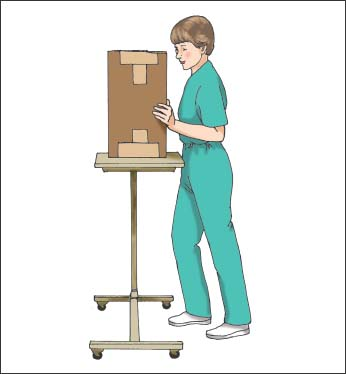Body Mechanics
Many patient care activities require the nurse to push, pull, lift, and carry. By using proper body mechanics, you can avoid musculoskeletal injury and fatigue and reduce the risk for injuring patients.
Correct body mechanics can be summed up in three principles: First, keep a low center of gravity by flexing the hips and knees instead of bending at the waist. This position distributes weight evenly between the upper and lower body and helps maintain balance. Second, create a wide base of support by spreading the feet apart. This tactic provides lateral stability and lowers the body’s center of gravity. Third, maintain proper body alignment and keep the body’s center of gravity directly over the base of support by moving the feet rather than twisting and bending at the waist. Keep the back, neck, pelvis, and feet aligned.
Implementation
Follow the directions below to push, pull, stoop, lift, and carry correctly.
Pushing and Pulling Correctly
Stand close to the object, and place one foot slightly ahead of the other, as in a walking position. Tighten your leg muscles and set your pelvis by simultaneously contracting the abdominal and gluteal muscles.
To push, place your hands on a stable part of the object and flex your elbows. Lean into the object by shifting weight from your back leg to your front leg, and apply smooth, continuous pressure (as shown below).

To pull, grasp the object and flex your elbows. Lean away from the object by shifting weight from your front leg to your back leg. Pull smoothly, avoiding sudden, jerky movements.
After you’ve started to move the object, keep it in motion; stopping and starting uses more energy.
Stay updated, free articles. Join our Telegram channel

Full access? Get Clinical Tree


Get Clinical Tree app for offline access
